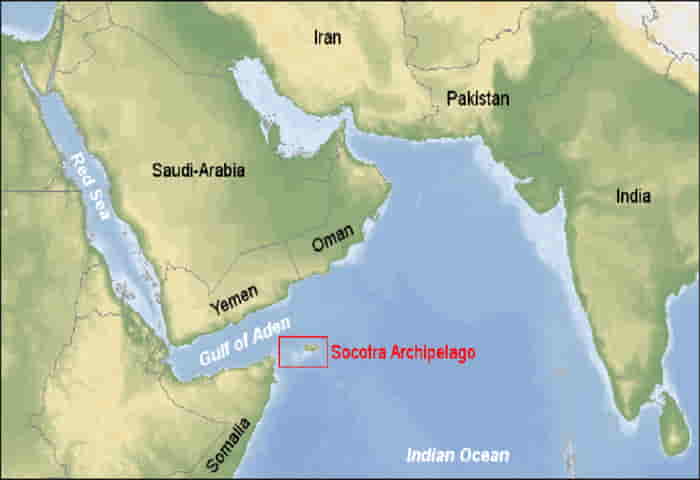Very few islands are as strategically located as the island of Socotra. Socotra, officially part of the state of Yemen and a declared UNESCO World Heritage Site.
The island is located at the crossroads of the Guardafui Channel, the Gulf of Aden, and the Arabian Sea. Socotra is perhaps closer to the African coast than the Arabian Peninsula. The foothold in Socotra enables any power to monitor the international shipping and petroleum traffic passing through the Gulf of Aden. As many as 18800 ships passed through the region even in the pandemic affected year of 2020 and therefore, the importance of the Gulf of Aden for the global economy is unparalleled. Consequently, Socotra too remains a prized possession. In the past, first imperial Britain and then during the Cold War, Soviet Union had established a foothold in Socotra. As of now, Socotra is dominated by the United Arab Emirates (UAE) supported Southern Transitional Council (STC).
In the Yemeni conflict, brewing since 2014, the government of Yemen led by President Abed Rabbo Mansur Hadi and Houthi rebels are two important players who are fighting each other. The government of Yemen was backed by Saudi Arabia and UAE and Houthis are supported by Iran. Saudi and UAE have intervened militarily, since 2015, to stop the Houthis. Despite the support of these regional powers, the Government of Yemen has not been able to defeat Houthi rebels. In fact, Saudi intervention in Yemen, including the blockade of ports through which humanitarian aid has been channeled to the vulnerable Yemeni population, has resulted in a humanitarian disaster with hunger and disease wrecking havoc. In this mix, STC needs to be added. It is an interesting player in the Yemeni context. It is part of the coalition that is ruling Yemen and yet is a separatist movement. It is in charge of Socotra and enjoys a firm backing of the UAE.
Also read: Reviving the Port of Berbera: Why India and the UAE can become partners in the Western Indian Ocean
In the last few years, UAE has emerged as a major military and economic power in the region abutting the Red Sea and the Gulf of Aden. It was probably the biggest beneficiary of the war in Yemen and has acquired military facilities to support its war efforts. UAE had acquired a foothold in the region through the military base at Assab (Eritrea) and deepening ties with the self-governing territory of Somaliland. It had also been building a military base at Berbera in Somaliland. However, since 2019, UAE’s strategy has undergone a change. UAE has dismantled its base at Assab and converted its Berbera facility into a civilian airport. It also withdrew from Aden. However, the reduction of military presence has not influenced the UAE’s thinking on Socotra.
In fact, UAE has been consolidating control over Socotra. UAE sent assistance to Socotra in the wake of two cyclones in 2015. They had a devastating impact on the island and the government of Yemen had all but abandoned the islanders. UAE played a major role in the post-cyclone reconstruction. Since then, UAE has established a firm foothold in the strategically significant territory. UAE now ‘bankrolls salaries and major infrastructure projects, ranging from schools and hospitals to communication systems and docks.’ It has built a communications network in Socotra that links directly to networks in UAE. It has financed infrastructure in Socotra and has gone as far as conducting its own census. UAE has taken prominent Socotri citizens to Abu Dhabi for free health care and special work permits. UAE is also bringing tourists to the Socotra and the visa process has no links with the Yemeni government. Apparently, tourists from Israel and the Gulf arrive in Socotra taking a two-hour flight from Abu Dhabi. It has also been reported that Yemeni tourists are not allowed on the island.
Also read: UAE adds Socotra to its dream of guarding the Gulf of Aden in the Indian Ocean
UAE understands the strategic importance of the island and has accelerated the building of military infrastructure. There have been suggestions of an Israeli intelligence facility at Socotra. It has also been rumored that UAE may hold a referendum in Socotra. It appears that UAE is unlikely to give up Socotra easily. Presence in southern Yemen, Somaliland, and control over Socotra enables UAE to project influence in the Gulf of Aden and monitor activities of its rivals such as Qatar and Turkey in the region. Concerns have been expressed about the probable environmental impact of the UAE’s activities in Socotra as the island is rich in biodiversity. However, strategic concerns are likely to take primacy over the environmental impact.
As of now, although the UAE is in control of the island, its exact intentions in Socotra remain unclear. UAE’s actions indicate a willingness to ensure a long-term presence. From an Indian point of view, in the context of growing Chinese presence in the Horn of Africa and East Africa, UAE’s emergence as a major player in the regional geopolitics may perhaps open up possibilities of further strategic cooperation.
(Sankalp Gurjar is a Research Fellow with the Indian Council of World Affairs, New Delhi. Views expressed are personal.)




















